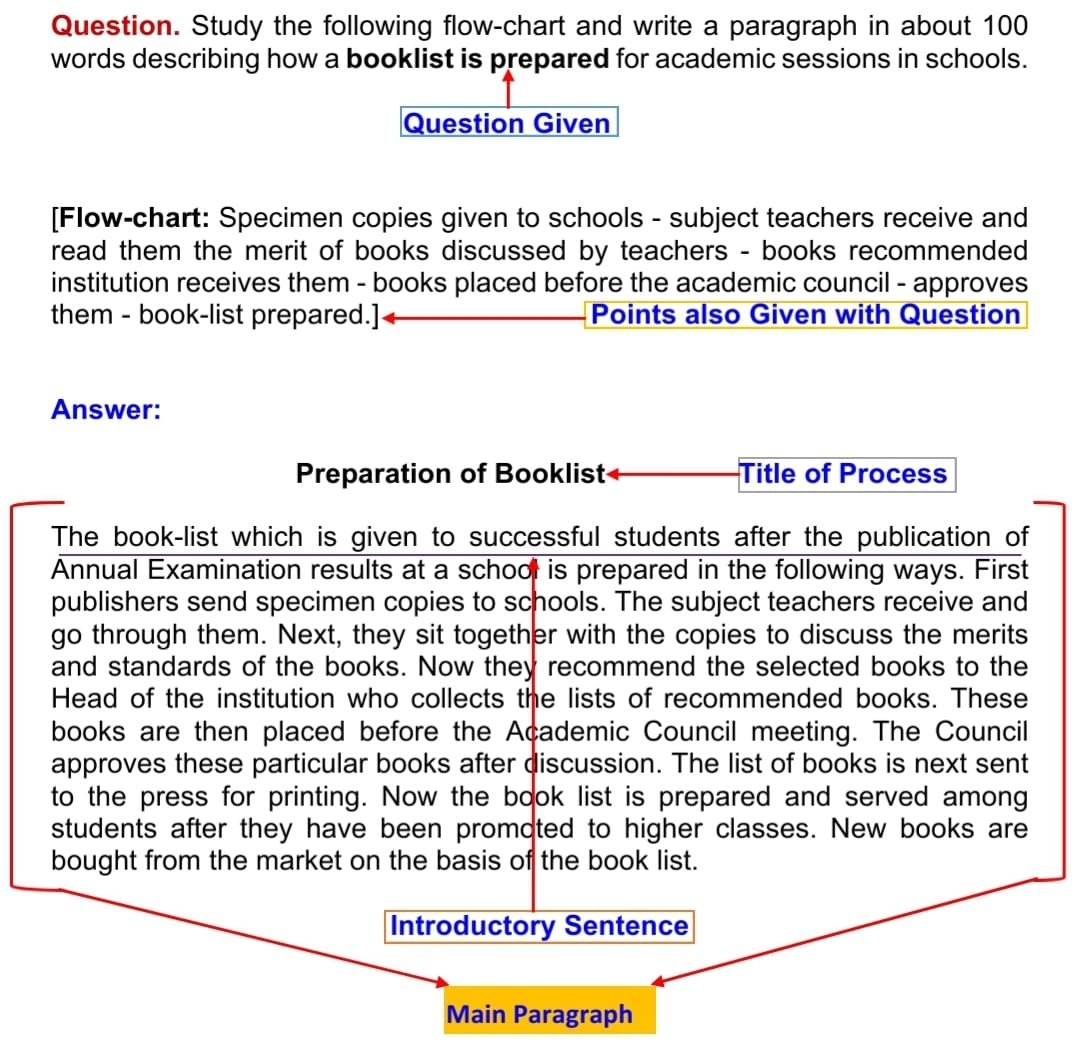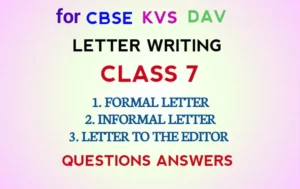Enhance your writing skills and achieve success in exams with our comprehensive guide on process writing class 10 format in English. This approach involves several stages, including pre-writing, drafting, revising, and editing, designed to help you produce well-structured, clear, and effective writing. With our guidance, you’ll master the art of process writing, making it easier to write high-quality essays and assignments under time pressure.
Process writing format topics with examples have been discussed below for Class 10. Process writing is an important writing skill topic for the Madhyamik English Exam.
What is Process Writing?
Process writing explains or describes how a particular thing is to be made. It contains a series of steps to be followed in producing that particular thing.
Steps for Process Writing Class 10 Format
For the writing process, the following steps must be maintained.
- First, a topic has to be chosen.
- A flowchart is given which indicates the different steps.
- A title has to be written at the start.
- A short paragraph has to be written on the basis of the given flowchart points.
- The sentence in the paragraph must be written in the passive voice and simple present tense, sometimes active voice may be used in writing those sentences.
- Linkers must be introduced at the beginning of each sentence in the paragraph.
- At first, Then, Now, After this, After that, Thereafter, Consequently, At last, Finally – may be used as linkers.
Specimen Process Writing Format for Class 10
Specimen process writing format is shown below with question answers for understanding the steps properly.

English Composition Resources:
Topics with Examples of Process Writing for Class 10.
Topics and Examples of Process Writing for Class 10 have given below important and necessary for the class 10 exam and those are very common to be found in previous different Exams.
How blood is collected from a donor’s body
13. Write a process on “How blood is collected from a donor’s body” in 120 words.
How blood is collected from a donor’s body
The process of collecting blood from a donor’s body involves several steps. First, a pre-donation screening is conducted to ensure the donor is eligible. Once approved, the donor is brought to a donation area, where a trained professional cleans their arm and inserts a sterile needle into a vein. Blood is then collected into a bag through the needle, typically in amounts of 1 pint. The entire process takes around 10-15 minutes, during which the donor is encouraged to relax and stay hydrated. After the blood is collected, the needle is removed, and a sterile bandage is applied to the puncture site. Donors are typically monitored for a brief period to ensure they are feeling well before being allowed to leave. The donated blood is then tested, processed, and distributed to hospitals or blood banks where it can be used to help save lives.
Rehydration Mixture
12. Study the following flowchart and write a paragraph on how the rehydration mixture is prepared.
[Flow-Chart: clean hands, clean pots, tea-spoon, table-spoon, cups; one litre boiled but cold sugar or honey ; 2 tablespoonfuls; – ordinary salt: teaspoonful; – orange juice:cup, – lemon juice: a few drops ; sodium bicarbonate (commonly called edible soda): teaspoonful; – stirring well; – ready.]
How Rehydration Mixture Is Made
A rehydration mixture that is a remedy for fatal dehydration or shortage of water in human body can be easily and promptly made at home following a series of steps. As the first step to this process hands and pots are thoroughly cleaned together with teaspoon, tablespoon and cups. Later, a pot is taken with one litre of boiled but cold water, 2 tablespoonfuls of sugar or honey are then carefully blended with it.½ tablespoonful of ordinary salt is mixed. Thereafter ½ cup of orange juice and a few drops of lemon juice are added together to the mixture. Again teaspoon of sodium bicarbonate or commonly called edible soda is poured upon it. All ingredients are stirred well to make up a compound. At last the patient can take this ready mixture four times a day.
Potato Chips
11. Study the following process and write a paragraph on how Potato Chips are made.
[Flow-Chart: potatoes collected; -sorted;- cleaned; – cut into round pieces; -added salt and spices; dried; – fried in oil; -packed and labelled; – ready to be marketed.]
Preparing Potato Chips
Right from assorting potatoes to preparing potato chips is a non-stop chain of stages to complete the process. Some quantities of potatoes are collected from market and brought to the factory. Better potatoes are sorted out from worse ones there. Thereafter they are cleaned in water. After drying, they are cut into very thin circular pieces. Later, salt and spices are added to the slice. Then the pieces in mats or jute bags are left open for drying in the sun and air. Next, they are fried deep in oil in a big cauldron Then follow packing and each packet is sealed and labeled with the brand name. Now they are finally ready to be delivered to market.
Process writing Class 10 on How a building is constructed:
10. Use the following flow-chart to write a paragraph (within 100 words) on how a building is constructed:
[drawing of a plan of the building by the architect – getting the plan sanctioned by the corporation or municipal authorities – engaging masons and labourers – starting the construction with bricks, cement, and sand – fitting doors and windows – plastering of walls – wiring – electric and water connections – painting-building completed – fit for living.]
How A Building is Constructed
One of the three primary requirements of human life is shelter. Civilized men construct buildings in order to secure this requirement. The construction of a building goes through a chain of well-planned activities.
First of all, the plan of the building is drawn by the architect as per the demand of the owner and the measurement of the land. Next, the plan is sanctioned by the corporation or municipal authority. After the plan is duly sanctioned, masons and labourers are engaged for the construction. Bricks, cement, sand etc. are bought according to the estimate of the masons. The construction is, thereafter, started. When the construction is primarily completed, doors and windows are fitted. The walls are now plastered. Wiring is done thereafter. Electric and water connections are also made in the meantime. The walls are painted inside and outside. Thus, the construction of the building is finally completed and it is now fit for living.
Process writing Class 10 on How mustard oil is prepared
9. Study the flow-chart below and write in about 70 words describing how mustard oil is prepared:
[Chart: Seeds are collected and dried – those seeds are put into hawler for crushing – a little water is added for extracting oil – oil cakes are separated – oil is collected in containers and sealed – oil is ready for sale.]
Mustard Oil
Mustard seeds are first collected from the market and dried well for about two weeks. Then the seeds are taken to the oil mill for extracting oil from them. There they are put into the hawler of a big crushing machine. A little water is added and it helps to extract oil. Oil cakes are separated from the oil. Then the extracted oil is collected in tin containers of different sizes. Next, these are properly sealed and labelled. Thus, the edible oil is made ready for use. It may be sent to market for sale.
Phenyl’s Preparation.
8. Below is an outline of the process of ‘phenyl’ preparation. Study it and describe the process in about 120 words :
[Outline: Mixing crushed resin with boiled castor oil – cooling-mixing caustic soda Solution – stirring solution frequently-pouring creosote oil – leaving it for 10 minutes – adding carbolic acid and potassium permanganate – pouring water constantly stirring – pouring into another pot and leaving for 24 hours.]
Phenyl PreparationTo prepare phenyl, first of all, the crushed resin is mixed with boiled castor oil. The mixture is then kept for cooling for some time. After the cooling is done, a solution of caustic soda is added to the mixture and it is stirred frequently for some time so that all the chemicals may get dissolved. After this, creosote oil is poured into the solution and it is left for ten minutes. Next carbolic acid and potassium permanganate are added to the mixture and some water is poured into the pot. Then the chemical mixture is continuously stirred for a few minutes and finally, the solution is poured into another pot and left there for twenty-four hours. Thus the phenyl is prepared and it can be effectively used to kill germs in different dirty places.
Guava Jelly’
7. Study the flow-chart below to write in about 100 words how ‘guava jelly’ is processed:
[Chart: Guavas are harvested and delivered-sorted and cleaned-boiled, crushed, and passed through sieve-crushed guava is mixed with lime and filled in sterilized bottles-sealed and labeled-put into boxes, and sent to shops.]
Processing of Guava Jelly
First, guavas are harvested from the orchard and delivered to the factory for the preparation of guava jelly. Thereafter fresh guavas are sorted out and the rotten ones are removed. Then they are cleaned well in water and boiled. Now the boiled guavas are crushed and passed through a sieve. The crushed guava is mixed with lime and boiled for a long period of time. The boiled mixture is again mixed with lime and preservatives. It is now ready for consumption. Then it is filled in sterilized bottles. Afterward, sealing and labelling are done. At last, the sealed and labelled bottles are delivered to shops for sale.
How Mixed Salad is Prepared
6. Study the following process of preparing a ‘mixed salad’. Then write a paragraph on how mixed salad is prepared :
[Chart: Peeling and slicing cucumber – slicing onions – cutting tomatoes chopping mint or coriander leaves – mincing chillies – squeezing out the juice of a lemon – sprinkling salt and pepper – adding salad oil – tossing the salad.]
Preparation of Mixed Salad
The preparation of mixed salad involves various stages. First, a few cucumbers are properly peeled and sliced and they are kept in a pot. Then a few onions are sliced and tomatoes are cut into small pieces. They are kept in the same pot. Next mint or coriander leaves are chopped and green chillies minced and put into the pot. Then the juice is squeezed out of a lemon and it is added to the ingredients. Now salt and pepper are sprinkled on them and some salad oil is added. At last, the mixture is stirred well and the mixed salad is made ready to be served.
The formation of rain.
5. Study the following flow-chart and write a paragraph about the formation of rain.
[Flow-chart: waters on the earth heated by sun rays; – water vapor formed; – rises high in the sky; comes in contact with cold air; – it becomes cooler; – it turns into clouds containing tiny water particles; float at large in the sky.]
Formation of Rain
How clouds bring refreshing showers for vegetation and the animal world is followed by a series of steps. The waters of ponds, canals, lakes, rivers, seas and oceans are heated by sunbeams. Thus the water vapour is formed and it rises higher and higher in the sky. Thereafter it comes in contact with the cold region of air in the vast sky. Naturally, it becomes cooler and cooler and condenses into water particles. This is a cloud replete with such particles. When the clouds in masses or patches are light in weight float at large in the sky. But when they are too heavy to be borne in the air they drop down as rain.
How Newspapers are Produced.
4. Study the following flow-chart. It tells you how newspapers are produced. Write a Paragraph in about 110 words describing the Process. Use an introductory sentence.
[Flow-chart: Press reporters collect news – Press photographers take pictures – news sorted and edited – types set in machines – paper rolls inserted – News printed – folded and cut – newspaper ready for distribution – delivered home .]
Production of Newspaper
We read newspapers but very few of us know how newspapers are produced. There is a chain of activities beginning from the collection of news to the delivery of printed newspapers at home. First, press reporters collect news that deserves to be published and the press photographers take pictures illustrating the news to be published. The collected news is then sorted and edited. Next comes the printing of the sorted news. Types are set in machines and paper rolls are inserted. Thus the news is printed on the newsprint. The papers are then folded and cut according to size. Newspapers are now ready for distribution to marketing agents. Finally, the newspapers are delivered to homes by hawkers.
Soap-Making
3. Study the following chart and describe the process of soap-making in about 100 words.
[Coconut oil, caustic soda, and water-heated for thirty minutes-allowed to cool-common salt added-kept for 12 hours-cut to cakes ready for use.]
Soap Making
Soap is very useful in our daily life. It is prepared through a number of steps. First, coconut oil and caustic soda are mixed with water. The solution is heated for thirty minutes. Then the heated solution is allowed to cool. After that, common salt is added to solution. It is left in that condition for twelve hours. As a result, the mixture becomes solid. Thereafter, it is cut to cake-like pieces. Now the soap cakes are ready for use. So we see that soap making is not very difficult. We can make it ourselves at home or in school.
How Paper is Made :
2. Study the following chart below to describe in about 100 words how ‘paper’ is made :
[Chart: Wood or bamboo cut up and cleaned – ground into a pulp-put into great tanks and mixed with lime-the boiled pulp is passed over wire-mesh–the wet paper is passed through another machine-wound into big rolls-cut into different sizes-double crown, double foolscap, demy-packed into reams.]
Paper Making
At first, wood or bamboo is cut up into pieces that are ground into a pulp in a big machine. Then the pulp is put into great tanks and mixed with lime in order to make the mixture soft and white. Next, the pulp is boiled and passed over a wire mesh which is kept moving by rollers. Thus, we have the wet paper which is once again passed through another machine with big rollers heated with steam. There the wet paper is pressed and dried. After that, this paper is wound into big rolls and cut into different sizes such as a double crown, double foolscap, and demy. Finally, the cut paper is packed into reams.
How Lemon Squash is made
1. Study the following chart below to describe in about 100 words how ‘Lemon Squash’ is made :
Making of Lemon Squash
The lemon squash is a favourite drink with everybody, especially in summer. The process of its preparation is an easy one and consists of a number of stages. At first, lemons are collected and scrubbed. Then the rind of the scrubbed lemons is scraped. In the next stage, the lemons are boiled in water. When the lemons cool, the juice is squeezed out of them. The juice is then strained through a fine sieve and gathered in a pot. Citric acid and sugar are then mixed with the juice. The mixture is then poured in dry, clean bottles The bottles are packed in cartons and sent to markets.







